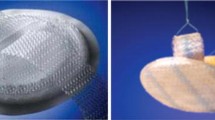Summary
To determine whether expanded polytetrafluoroethylene (ePTFE) patches impregnated with silver and chlorhexidine produce any adverse effects, we compared patients in whom impregnated and standard ePTFE patches were implanted at hernia repair. Patients undergoing open or laparoscopic prosthetic inguinal or ventral hernia repair were randomly assigned to receive either an impregnated (n=18) or standard (n=19) ePTFE patch. Assessments were performed preoperatively and on days 7–10, 40–44, and 80–84 postoperatively. Mean values from standard blood tests and urinalyses were within normal ranges in both study groups. The standard-patch group had a higher mean alkaline phosphatase concentration (p=0.02), probably because of two outlying values. In the impregnated-patch group, there was one prolonged ileus and two postoperative seromas. The addition of silver and chlorhexidine to ePTFE patches does not appear to produce any adverse systemic or clinical effects after hernia repair.
Similar content being viewed by others
References
Bauer JJ, Salky BA, Gelernt IM, Kreel I (1987) Repair of large abdominal wall defects with expanded polytetrafluoroethylene (PTFE). Ann Surg 58: 765–769
Bellón JM, Contreras LA, Sabater C, Bujàn J (1997) Pathologic and clinical aspects of large incisional hernias after implant of a polytetrafluoroethylene prosthesis. World J Surg 21: 402–407
Bergqvist-Karlsson A (1988) Delayed and immediate-type hypersensitivity to chlorhexidine. Contact Dermatitis 18: 84–88
Darouiche RO, Raad II, Heard SO, Thornby JI, Wenker OC, Gabrielli A, Berg J, Khardori N, Hanna H, Hachem R, Harris RL, Mayhall G, for the Catheter Study Group (1999) A comparison of two antimicrobial-impregnated central venous catheters. N EngI J Med 340: 1–8
DeBord JR (1995) The rationale for the selection of a prosthetic material in hernia repair. Probl Gen Surg 12: 75–78
Elek SD, Conen PE (1957) The virulence of Staphylococcus pyogenes for man: a study of the problem of wound infection. Br J Exp Pathol 38: 573–579
Fung MC, Bowen DL (1996) Silver products for medical indications: risk-benefit analysis. Clin Toxicol 34: 119–126
Gamelli RL, Paxton TP, O'Reilly M (1993) Bone marrow toxicity by silver sulfadiazine. Surg Gynecol Obstet 177: 115–120
Gilbert AI, Feiton LL (1993) Infection in inguinal hernia repair considering biomaterials and antibiotics. Surg Gynecol Obstet 177: 126–130
GORE-TEX DualMesh Plus and MycroMesh Plus are registeral trademarks of W.L. Gore & Associates, Inc., Flagstaff, Arizona, USA.
Gristina AC (1987) Biomaterial-centered infection: microbial adhesion versus tissue integration. Science 237: 1588–1595
Hesselink VJ, Luijendijk RW, de Wilt JHW, Heide R, Jeekel J (1993) An evaluation of risk factors in incisional hernia recurrence. Surg Gynecol Obstet 176: 228–234
Hollinger MA (1993) Toxicological aspects of topical silver pharmaceuticals. Crit Rev Toxicol 26: 255–260
Houck JP, Rypins EB, Sarfeh IJ, Juler GL, Shimoda KJ (1989) Repair of incisional hernia. Surg Gynecol Obstet 169: 397–399
Jansen B, Rinck M, Wolbring P, Strohmeier A, Jahns T (1994) In vitro evaluation of the antimicrobial efficacy and biocompatibility of a silver-coated central venous catheter. JáBiomater Appl 9: 55–70
Lichtenstein IL, Shulman AG, Amid PK, Montllor MM (1989) The tension-free hernioplasty. Am J Surg 157: 188–193
Maki DG, Stolz SM, Wheeler S, Mermel LA (1997) Prevention of central venous catheter-related bloodstream infection by use of an antiseptic-impregnated catheter. A randomized, controlled trial. Ann Intern Med 127: 257–266
Quesnel LB, Al-Najjar AR, Buddhavudhikrai P (1978) Synergism between chlorhexidine and sulphadiazine. J Appl Bacteriol 45: 397–405
Ramshaw BJ, Tucker JG, Duncan TD, Heithold D, Garcha I, Mason EM, Wilson JP, Lucas GW (1996) Technical considerations of the different approaches to laparoscopic herniorrhaphy: an analysis of 500 cases. Am Surg 62: 69–72
Seid AS (1994) Prosthetic biomaterials in hernia repair. In: Arregui ME, Nagan RF (eds) Inguinal hernia: advances or controversies? Radcliffe Medical Press, Oxford, pp 505–510
Wantz GE (1991) Incisional hernioplasty with Mersilene. Surg Gynecol Obstet 172: 129–137
Author information
Authors and Affiliations
Rights and permissions
About this article
Cite this article
DeBord, J.R., Bauer, J.J., Grischkan, D.M. et al. Short-term study on the safety of antimicrobial-agent-impregnated ePTFE patches for hernia repair. Hernia 3, 189–193 (1999). https://doi.org/10.1007/BF01194424
Received:
Accepted:
Issue Date:
DOI: https://doi.org/10.1007/BF01194424




